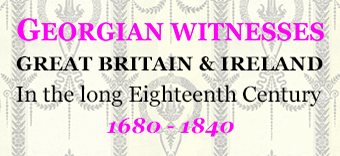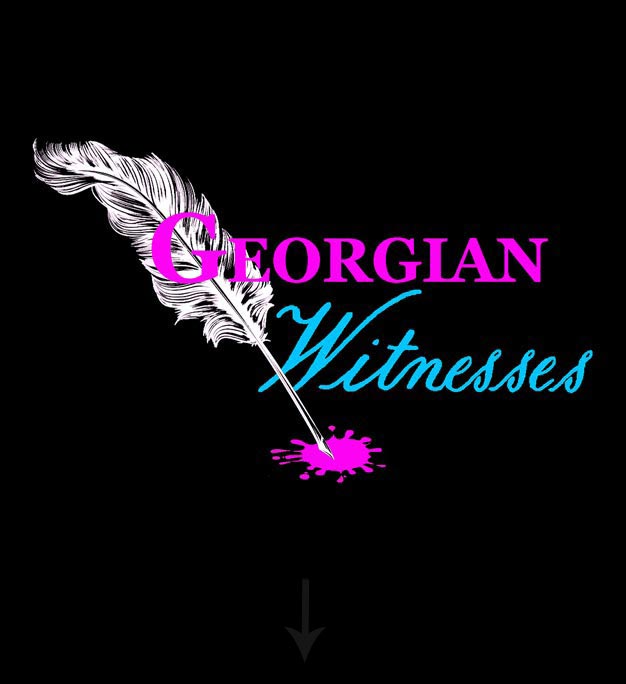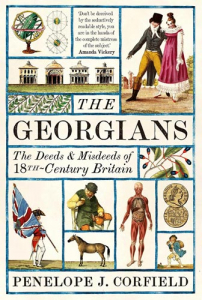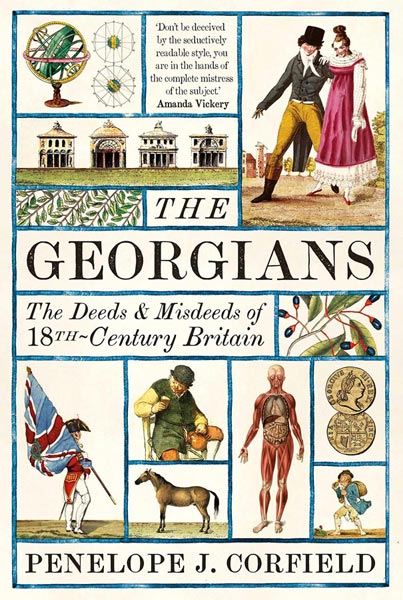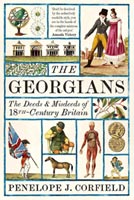Listing 1: Introducing the Georgians – and placing them in historical context with three images of through-time linkages, plus three sets of symbols of Georgian Britain & Ireland and three intimate relics, signalling the immediacy of the past.
Listing 2: Nine travelogues (real + fictitious) plus six places to visit referencing immigration to Britain & Ireland and six places to visit overseas and in UK referencing British emigration.
Listing 3: Nine meditative / pessimistic C18 poems.
Listing 4: Six Georgian comedies.
Listing 5: Nine diaries from the long eighteenth century plus six places to visit in UK/ overseas referencing the globalisation of tastes.
Listing 6: Nine Georgian testimonies to the variegated arts of love plus nine Georgian novels about the quest for love and self-knowledge.
Listing 7: Three key Georgian educational resources plus nine Georgian libraries – cathedrals of the new world of literacy – plus one great Victorian library for good measure.
Listing 8: Nine Georgian contributions to religious worship plus nine monuments / contributions to scepticism.
Listing 9: Nine commemorations of Georgian power-broking, expressing a multi-faceted view of power by referencing taxation; military prowess; naval prowess; the civil service; the royal court; politicians in power; politicians in opposition; notable femocrats; parliament.
Listing 10: Six sites of contest, where different forms of popular politics were conducted ‘out-of-doors’ – both peacefully and at times with violence and bloodshed – plus one individual campaigner for political liberty.
Listing 11: Nine contributions to debates on social welfare, including three testimonies to mental anguish; plus three testimonies to the travails of poverty; plus two ballads about the gallows and one reasoned objection to the death penalty.
Listing 12: Nine contributions to Abolitionist campaigns against the slave trade and then against the institution of slavery, including the power of graphic imagery; plus oratory; African testimony, theatre; petitions; and campaign organisation.
Listing 13: Testaments to grandeur and wealth, via nine conspicuous Georgian houses; plus nine great long-eighteenth-century gardens; plus nine monuments and/or follies.
Listing 14: Testaments to the emergent middle class, via five case-histories of families aspiring; rising; rising high; steady-stating; and failing; plus four commentaries on the ‘middle state’.
Listing 15: Testaments of Georgian workers, via three different responses to industrial grievances – organised trade unionism – anonymous threats – Luddite machine-breaking; plus five different campaigners for a new social and/or political order; plus one anonymous song, greeting the advent of the workers (1795).
Listing 16: Georgian celebrity culture, illustrated by 300 non-royal and non-noble celebrities, who achieved fame in their own day, plus one individual who lived and worked in obscurity but is now better known than most – but not all – of these celebs.
Listing 17: Georgian science and technology, illustrated via nine images of eighteenth-century craft workshops and industrial workplaces, plus two engineering feats plus one famous literary warning about the dangers of untrammelled invention.
Listing 18: Documenting Georgian Urbanisation via a selection of notable buildings and street scenes that survive today, including nine Assembly Rooms; nine notable town houses; nine market houses or market crosses; nine Georgian town halls; nine urban street scenes, nine town walks or promenades; nine Georgian theatres; nine Georgian artists who painted townscapes; and nine urban venues of special interest.
Listing 19: Perspectives on long-term assessments of the Georgian era, looking in turn at deep continuities; plus gradual evolutionary changes; plus drastic, sudden and revolutionary changes; and a final compound image of these categories interlocking.
Listing 20: names of 119 Georgians being actively commemorated today, by Societies founded in their names or to further their causes; plus four societies organised around significant eighteenth-century dates; plus the one Georgian outlaw who today has a football team named after him.
Coda – Listing 21: Three Georgian songs, of which two are often sung today.
